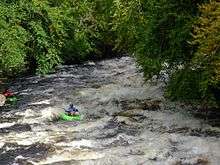Whitewater sports
Whitewater sports are the art of bobbing about in a boat, large or small, in moving water. You can also do more quiet journeys, with only the occasional rapid, mostly enjoying the landscape and your company. Some of the most remote and beautiful areas of the world can be seen during one of these adventures.

Kayaks and canoes used for whitewater tours have one or two paddlers, while whitewater rafts usually seat more people. Traditionally also rowing boats, big or small, have been taken through rapids. There are also river bugs, very small one person crafts.
Rafting is more accessible for the casual traveler, as navigation is handled by a professional and even beginners can come along for a white-knuckled ride. With kayaks and canoes, a professional guide can guide a company and give instructions, but once in a rapid you are on your own. On the other hand, a kayak or canoe is useful also along minor waterways.
Rapids are graded by class to indicate their rough difficulty level. The practical scale ranges from class I (no skill needed) to class V (experts only), with class VI rapids considered hazardous even to pros. Don't place too much faith on the letter though: difficulty can vary considerably based on the season and the water level, and rivers of one grade may have harder individual rapids that need to be portaged (boat carried) past.
Different types of tours

Rafting, canoeing or kayaking is not always fast, big water adventures. Instead of choosing just the whitewater parts of a river, you can float or paddle along the more quiet parts, or paddle in lakes. The less whitewatery journeys are often mostly or partly about wildlife viewing and nature, but there are also e.g. culinary rafting trips and even spiritual and yoga rafting retreats. The rafting travel industry has branched out to all demographics and travel desires.
Especially longer canoe or kayak journeys often combine the elements: the river may partly be a series of lakes and also many river parts may be quiet, but between these there are also rapids or series of rapids – if we are talking about whitewater sports. For quiet canoe and kayak trips, also advice on sea kayaking and wilderness backpacking may be relevant.
Experts have developed sports and even arts out of going down rapids: one approach is river running, where the paddler tries to mostly use features of the rapid rather than the paddle to steer the craft, another is playboating, where the features are used for doing tricks, such as surfing, spinning and flips.
Approaching rapids
One should never get into a rapid without preparations. The rapids change a lot depending on water level and the best route may be affected by this. There may even be fallen trees blocking the passage. A tour organizer may have studied the rapids beforehand, but especially on wilderness journeys, expect to take a walk to study the rapids before deciding how difficult it will be and what route to take. An experienced person is able to deduce depths and streams from the looks of the water. With a kayak or canoe, you must also be capable of recognizing the different sections while in action. If the rapids are too difficult, you will have to carry your craft past the rapids (in some cases it is also possible to lead it from ashore, guiding it with ropes).
Destinations
South Africa
The African Paddling Association is a voluntary group that focuses on developing paddling sports of all kinds in South Africa.
Many operators offer training courses, guided expeditions and short outings. Clubs will also be able to guide you to the best water around.
Indonesia
- Pekalen River, Probolinggo, East Java
United States
Europe
- Croatia
- Russia
- Turkey
- Slovenia
- SocaRider, e-mail: info@socarider.com. Focusing more on small group trips and nice familiar atmosphere. Offers Whitewater kayak courses from beginner to advance level, easy Kayak Trips for beginners, and Family rafting trips for families with small kids from the age of 4.
- Bosnia and Herzegovina
Learn
Buy
Stay safe
- Be sure you understand the nature of the trip and what level of expertise is expected from you.
- Use safety gear, such as helmets and life jackets.
- Secure your equipment.